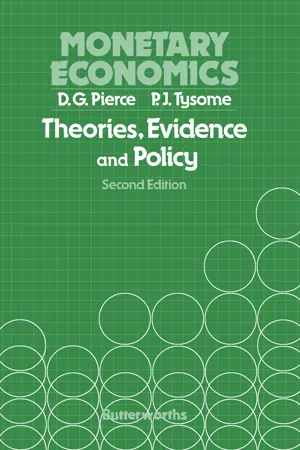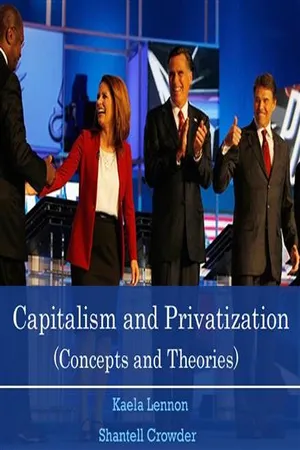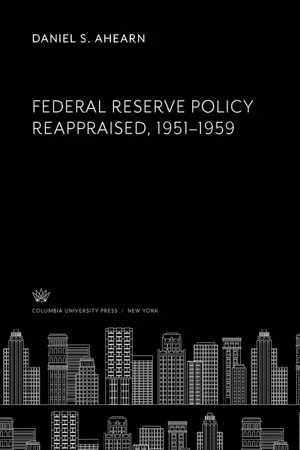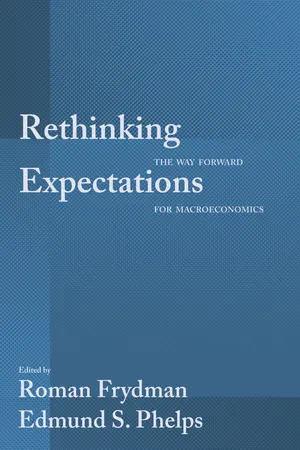Economics
Discretionary Monetary Policy
Discretionary monetary policy refers to the deliberate actions taken by a central bank to influence the economy through changes in interest rates, reserve requirements, and open market operations. This policy is implemented in response to current economic conditions and is not based on predetermined rules or formulas. It allows central banks to adjust their strategies in real time to address economic challenges.
Written by Perlego with AI-assistance
Related key terms
1 of 5
9 Key excerpts on "Discretionary Monetary Policy"
- eBook - PDF
Monetary Economics
Theories, Evidence and Policy
- David G. Pierce, Peter J. Tysome(Authors)
- 2014(Publication Date)
- Butterworth-Heinemann(Publisher)
Thirdly the indicator should primarily be influenced by policy action and only to a much lesser extent influenced in the same period by non-policy variables, or it must be possible to separate and identify the policy and non-policy influences on the indicator. Finally the indicator should bear a stable and close relationship to the target of policy. 244 Monetary policy: targets, indicators, rules and discretion Rules versus discretion In this final section we consider the question of whether monetary policy should be conducted at the discretion of the authorities or on the basis of a predetermined rule or automatic pilot. Discretionary monetary pohcy means operating the weapons of monetary control in the direction, manner and extent considered appropriate by the monetary authorities in the light of the relevant economic circumstances and the desired economic goals. Monetary rules means operating monetary policy according to a predetermined rule, largely irrespective of prevailing economic circumstances. Several rules have been suggested, but perhaps the most widely discussed is that by which the money supply would be expanded at a fairly uniform rate over time. The monetarist case for the abandonment of discretionary or activist monetary pohcies and the adoption of a monetary rule has several strands to it. We shall find it useful to consider them under three headings: (1) Activist pohcies are unnecessary. (2) They can not be successful and may be positively harmful. (3) There are definite benefits of using a monetary rule. Activist policies are unnecessary Monetarists argue that an activist monetary policy is unnecessary because the economy is inherently stable and any fluctuations that do occur will be short-lived. This view was originally presented in terms of the slopes and stability of the IS and LM curves. - No longer available |Learn more
- (Author)
- 2014(Publication Date)
- Library Press(Publisher)
____________________ WORLDTECHNOLOGIES ____________________ Chapter- 4 Monetary Policy Monetary policy is the process by which the monetary authority of a country controls the supply of money, often targeting a rate of interest for the purpose of promoting economic growth and stability. The official goals usually include relatively stable prices and low unemployment. Monetary theory provides insight into how to craft optimal monetary policy. Monetary policy is referred to as either being expansionary or contractionary, where an expansionary policy increases the total supply of money in the economy more rapidly than usual, and contractionary policy expands the money supply more slowly than usual or even shrinks it. Expansionary policy is traditionally used to try to combat un-employment in a recession by lowering interest rates in the hope that easy credit will entice businesses into expanding. Contractionary policy is intended to slow inflation in hopes of avoiding the resulting distortions and deterioration of asset values. Monetary policy differs from fiscal policy, which refers to taxation, government spending, and associated borrowing. Overview Monetary policy rests on the relationship between the rates of interest in an economy, that is, the price at which money can be borrowed, and the total supply of money. Monetary policy uses a variety of tools to control one or both of these, to influence outcomes like economic growth, inflation, exchange rates with other currencies and unemployment. Where currency is under a monopoly of issuance, or where there is a regulated system of issuing currency through banks which are tied to a central bank, the monetary authority has the ability to alter the money supply and thus influence the interest rate (to achieve policy goals). The beginning of monetary policy as such comes from the late 19th century, where it was used to maintain the gold standard. - No longer available |Learn more
- (Author)
- 2014(Publication Date)
- College Publishing House(Publisher)
____________________ WORLD TECHNOLOGIES ____________________ Chapter- 4 Monetary Policy Monetary policy is the process by which the monetary authority of a country controls the supply of money, often targeting a rate of interest for the purpose of promoting economic growth and stability. The official goals usually include relatively stable prices and low unemployment. Monetary theory provides insight into how to craft optimal monetary policy. Monetary policy is referred to as either being expansionary or contractionary, where an expansionary policy increases the total supply of money in the economy more rapidly than usual, and contractionary policy expands the money supply more slowly than usual or even shrinks it. Expansionary policy is traditionally used to try to combat unemployment in a recession by lowering interest rates in the hope that easy credit will entice businesses into expanding. Contractionary policy is intended to slow inflation in hopes of avoiding the resulting distortions and deterioration of asset values. Monetary policy differs from fiscal policy, which refers to taxation, government spending, and associated borrowing. Overview Monetary policy rests on the relationship between the rates of interest in an economy, that is, the price at which money can be borrowed, and the total supply of money. Monetary policy uses a variety of tools to control one or both of these, to influence outcomes like economic growth, inflation, exchange rates with other currencies and unemployment. Where currency is under a monopoly of issuance, or where there is a regulated system of issuing currency through banks which are tied to a central bank, the monetary authority has the ability to alter the money supply and thus influence the interest rate (to achieve policy goals). The beginning of monetary policy as such comes from the late 19th century, where it was used to maintain the gold standard. - eBook - PDF
Monetary Economics
Policy and its Theoretical Basis
- Keith Bain, Peter Howells(Authors)
- 2017(Publication Date)
- Red Globe Press(Publisher)
This suggests either that voters do not under-stand what they are doing, and moreover do not learn. Or, that they are perfect-ly well-informed but acting rationally in voting for their own preference. This suggests again that the overwhelming merits of low inflation may be more appar-ent to economists than to the general public. Be that as it may, the idea that governments are subject to pressures which encourage inflationary policy is quite widely established and, as we said at the beginning of this section, it gives rise to the argument that policy might be improved if the policymaker’s freedom of action could be constrained in some way — maybe the requirement to follow a rule. A rather different case against Discretionary Monetary Policy has been made in terms of its feasibility: that an activist policy is too difficult to operate and is The optimal design of monetary policy 238 bound, in practice, to make things worse rather than better. There are several strands to this argument. Firstly, a beneficial application of discretionary policy requires that the authorities know with some precision how different policies are likely to affect Rules and discretion 239 The stylised balance sheets below are taken from box 2.2. Suppose that the deficit = £1bn. The central bank lends £1bn to the government and credits govern-ment deposits accordingly. The loan is an asset to the central bank (it makes no difference whether it is a conventional loan or a purchase of new government securities) and the new deposits are an addi-tional liability. So on each side we show the change as (+). But the government has borrowed only to finance the deficit and so it spends the new deposits on purchases from the private sector adding to customer deposits in commercial banks. So we now have (-) against government deposits at the central bank and (+) against customer deposits. - Daniel S. Ahearn(Author)
- 2019(Publication Date)
- Columbia University Press(Publisher)
But the fixed rule would not at all affect the lag between the time actions are taken and the time they have effect on the economy, and this lag is the main reason, according to Friedman, that discre-tionary monetary policy has been destabilizing. Friedman said: 19 Joint Committee, 1959 Staff Report, p. 404. CONTROL OF THE MONEY SUPPLY 231 Monetary and fiscal policy is rather like a water tap that you turn on now and that then only starts to run 6, 9, 12, 16 months from now. It is be-cause of this long lag in the reaction to policy that you have this tendency for policy in fact to have an effect opposite to that intended. 2 ^ This sort of lag would be troublesome for any monetary actions, discretionary or automatic. It might be said that since all money-supply changes under the automatic rule would be at the same rate, for example, 4 percent a year, lags in their impact would be irrele-vant; whenever they took effect, their impact would be the same. But what matters for the economy is not simply the amount of money created but the money conditions created by the interaction of the 4 percent increase in money supply and the incremental demand for money and these vary considerably. In prosperous periods demand for money could outrun a 4 percent increase in supply and create tight money conditions; in recessions, easy money could result from the fact that the incremental demand for money fell short of the 4 percent rise in supply. Just as with discretionary policy, lags could mean that tight money had its effect in the following recession, while easy money took effect in a prosperous period. Thus, so far as lags are concerned, there is little to be gained from replacement of discretionary control over the money supply by a rule calling for an automatic 4 percent annual increase in money supply.- eBook - PDF
Money and the Rule of Law
Generality and Predictability in Monetary Institutions
- Peter J. Boettke, Alexander William Salter, Daniel J. Smith(Authors)
- 2021(Publication Date)
- Cambridge University Press(Publisher)
But once it’s clear that a crisis is truly systemic, underreacting is much more dangerous than overreacting, too late creates more problems than too early, and half measures can just pour gasoline on the flames. These technical problems include the task of deciding, concomitantly with other policymakers and other appointed officials, where to interject the policy tool. For instance, monetary policy can work by injecting bank reserves to lower interest rates, or (much more worryingly) it can be used to finance deficit spending, enabling policymakers to potentially direct it toward specific industries or groups (Horwitz 2000, p. 117). 12 Measures such as this often skirt the line between fiscal and monetary policy. 12 The Bank of Japan, which has extensive experience with discretionary policy in low interest rate environments, attempted monetary injections via the purchase of exchange- 32 Knowledge Problems with Discretionary Monetary Policy 2.2.4 Problems with Calibrating Models Forecasting models are necessary to gauge the appropriateness and extent of proposed monetary interventions, as well as to assess their effectiveness. Calibrating these models represents the final technical problem that dis- cretionary central bankers face. The possible barometers for measuring the state of the economy range from the conventional, such as interest rates, the labor market, and the housing market, to the unconventional, such as dry cleaning and men’s underwear sales (Pashman 2007) or the price of gold (Lastrapes and Selgin 1996). Once an economic indicator (or a weighted group of economic indicators) can be identified from the endless list of potential barometers, monetary authorities then face the technical problem of identifying the specific measurement of that indicator that would be most appropriate. These technical problems emerge, in part, because it is often difficult to define these indicators, let alone agree on an indicator. - eBook - ePub
- Anna J. Schwartz(Author)
- 2009(Publication Date)
- University of Chicago Press(Publisher)
Section 10.5 concludes with a brief discussion of the role that a constant monetary growth rule plays in the views of the schools of global monetarism, of Austrian economics, and of the new monetary economics.10.1 The Case against Discretionary Monetary PolicyThe general case against Discretionary Monetary Policy formulated by Friedman (1953) is that, to function well, stabilization policy must offset random disturbances to economic activity; that is, it should remove the variation in income due to those disturbances. To achieve such a goal, two conditions must be satisfied: one involving timing, and the other involving the magnitude of the policy action. The timing of the policy action should conform to that of the disturbance, and the size of the policy action should be congruent with the size of the disturbance. If both conditions are not satisfied, the policy response will be insufficient and may even be destabilizing.Friedman (1948, 1953) went on to argue that the lags in the effect of Discretionary Monetary Policy are likely to be long and variable, reflecting both an “inside lag”—the time that elapsed before the monetary authority responded to the disturbance—and an “outside lag”—the time that elapsed before changes in monetary growth affect economic activity. As a result, discretionary policy actions might exacerbate rather than mitigate cyclical disturbances. In addition, Friedman contended that there was no basis for believing that policymakers (and the economics profession) possess the detailed knowledge of the economy’s complex interactions and of the lag structure requisite for the pursuit of successful countercyclical policies or for fine-tuning. Furthermore, in his view, even well-meaning monetary authorities were likely to respond to political influences. Politically advantageous, short-run actions by the authorities would ignore the long-run destabilizing consequences. The conclusion Friedman drew from this array of circumstances and from evidence to be considered in what follows was that monetary policy should be based on a legislated rule instructing the Federal Reserve to increase the quantity of money, or high-powered money, on a year-to-year basis at a steady known rate of growth. - eBook - PDF
Economics for Investment Decision Makers
Micro, Macro, and International Economics
- Christopher D. Piros, Jerald E. Pinto(Authors)
- 2013(Publication Date)
- Wiley(Publisher)
c. The Bank shall be fully accountable for its judgments and actions in implementing monetary policy. “Indirect taxes” refer to such taxes as sales taxes and value-added taxes that are levied on goods and services rather than directly on individuals and companies. Source: www.rbnz.govt.nz/. Chapter 7 Monetary and Fiscal Policy 363 In other words, it has been argued that inflation targeting might compromise the goal of “maximum employment.” In practice, however, the Fed has indicated that it sees core inflation measured by the personal consumption expenditure (PCE) deflator of about, or just below, 2 percent as being compatible with “stable prices.” Financial markets therefore watch this U.S. inflation gauge very carefully in order to try to anticipate the rate actions of the Fed. 2.3.4.4. Monetary Policy in Developing Countries Developing economies often face signif- icant impediments to the successful operation of any monetary policy—that is, the achieve- ment of price stability. These include: The absence of a sufficiently liquid government bond market and developed interbank market through which monetary policy can be conducted. A rapidly changing economy, making it difficult to understand what the neutral rate might be and what the equilibrium relationship between monetary aggregates and the real economy might be. Rapid financial innovation that frequently changes the definition of the money supply. A poor track record in controlling inflation in the past, making monetary policy intentions less credible. An unwillingness of governments to grant genuine independence to the central bank. Taken together, any or all of these impediments might call into question the effectiveness of any developing economy’s monetary policy framework, making any related monetary policy goals difficult to achieve. - eBook - PDF
Rethinking Expectations
The Way Forward for Macroeconomics
- Roman Frydman, Edmund S. Phelps, Roman Frydman, Edmund S. Phelps, Roman Frydman, Edmund Phelps(Authors)
- 2013(Publication Date)
- Princeton University Press(Publisher)
Early in 2009 I wrote that the danger I see is that as the recovery begins, or after we are a couple of years into it, people may feel that it’s not fast enough, or there is an unpleasant pause. Either could generate heavy pressure on the Fed to intervene. . . . Why would such interventions only take place in times of crisis? Why wouldn’t future Fed officials use them to try to make economic expansions stronger or to assist certain sectors and industries for other reasons? [Taylor 2009: 98] Fed officials dismissed concerns about such a scenario, saying that it was an emergency. Yet this is exactly the scenario that has played out. The recovery paused, and then there was a QE2. A closely related explanation for the shift back toward discretion is that policymakers tried to do more than the underlying economics suggested was possible. After two decades of the Great Moderation, policymakers wanted to do even better. So they kept interest rates extra low and intervened in other ways, trying to reduce downside risks. This problem is common in decisionmaking, as Milton Friedman pointed out many years ago in a debate with Walter Heller (1969) over rules versus discretion: The available evidence . . . casts grave doubts on the possibility of pro- ducing any fine adjustments in economic activity by fine adjustments in monetary policy—at least in the present state of knowledge. . . . There are thus serious limitations to the possibility of a discretionary mone- tary policy and much danger that such a policy may make matters worse rather than better . . . . The basic difficulties and limitations of monetary policy apply with equal force to fiscal policy . . . . Political pressures to ‘do something’ . . . are clearly very strong indeed in the existing state of public attitudes. The main moral to be drawn from the two preceding points is that yielding to these pressures may frequently do more harm than good.
Index pages curate the most relevant extracts from our library of academic textbooks. They’ve been created using an in-house natural language model (NLM), each adding context and meaning to key research topics.








